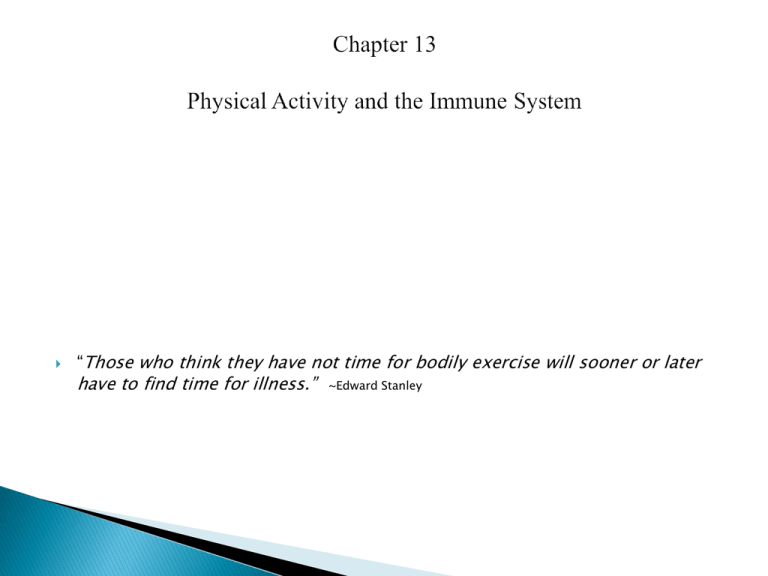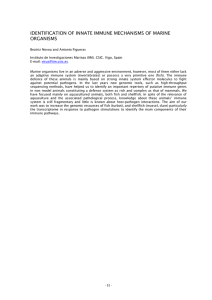Those who think they have not time for bodily exercise... have to find time for illness.”
advertisement

“Those who think they have not time for bodily exercise will sooner or later have to find time for illness.” ~Edward Stanley The possibility that moderate levels of physical activity may have on the immune system is a likely explanation for general benefits that might extend to several types of cancers. Persistent Inflammation may be a part of the pathogenesis in tumor growth and development of atherosclerosis, insulin resistance and neurodegenerative diseases of the CNS so—regular exercise may help against CVD, NIDDM, dementia, and depression through antiinflammatory effects either by reduction in abdominal fat that secretes inflammatory cytokines or through release of anti-inflammatory myokines during skeletal muscle contraction. The acute effects of exercise on the immune system were first reported over 100 years ago, when German physiologist G. Schulz (1893) noted that muscle contractions produced an increase in the number of leukocytes circulating in the blood. Physical activity may also influence the risk of infection. (some increase/some decrease). Hypothesis: physical inactivity leads to the accumulation of visceral fat and consequently to the activation of a network of inflammatory pathways, which promote the development of insulin resistance, atherosclerosis, neurodegeneration and tumor growth, leading to the development of “the diseasome of physical inactivity”. ©2011 by The Company of Biologists Ltd Whether activity affects the immune system in a way that meaningfully reduces the risk of developing cancer or other chronic diseases is even less well established. No studies have shown such benefits among humans. The immune system is an integrated network of molecules, cells, tissues, and organs that defend an organism against infections by foreign substances (bacteria/viruses) and against mutated native cells (tumors). It also helps to repair damaged tissues and to clean up the debris of dead cells (after muscle injury). 2 types of immunities: (1) Innate (natural) and (2) adaptive (acquired). Innate means that immune cells can recognize a foreign substance (antigen) without prior exposure. Adaptive refers to immune cells memory whereby they recognize a pathogen from prior encounter, permitting a quicker and larger immune response upon a subsequent exposure. Innate immunity provides the initial defense against various infectious agents and cancer. It can be activated by pathogens to which an organism is exposed through contact with skin, inhalation, or ingestion of food and water. Innate immunity can also be activated by tissue necrosis (muscle damage through exercise) or release of heat shock or oxidative stress proteins from the liver, heart and skeletal muscle. Adaptive or acquired immunity is able to recognize highly specific antigens as a result of previous exposure and offers different responses to different types of microbes. Cells of the Immune System: Leukocytes—white blood cells; Lymphocytes are the major cells of adaptive immunity. An antibody (Ab), also known as an immunoglobulin (Ig), is a large Y-shaped protein produced by B-cells that is used by the immune system to identify and neutralize foreign objects such as bacteria and viruses. The antibody recognizes a unique part of the foreign target, called an antigen.[1][2] The production of antibodies is the main function of the humoral immune system.[3 T cells or T lymphocytes are a type of lymphocytes (itself a type of white blood cells) that play a central role in cell-mediated immunity. They can be distinguished from other lymphocytes, such as B cells and natural killer cells (NK cells), by the presence of a T-cell receptor (TCR) on the cell surface. They do not have antigenpresenting properties (but rather, requiring B cells or NK cells for its antigenpresenting property). They are called T cells because they mature in the thymus. Natural Killer cells are a class of large, granular lymphocytes found in blood and lymphoid organs, especially the spleen. They do not require prior exposure to recognize an antigen and thus play an important role in innate immunity. Acute exercise increases the numbers and possibly the activity of NK cells in the blood. The Thymus Gland Imagine one gland in the body which is as big as a man’s fist when we are born controlling how we react and whether we are immune to life, comments or disease. And this one gland shrinks to the size of our thumbnail, as we get older. This crucial gland is the THYMUS gland. Monocytes are a type of white blood cell and are part of the innate immune system of vertebrates including all mammals (humans included), birds, reptiles, and fish. Monocytes play multiple roles in immune function. Such roles include: (1) replenish resident macrophages and dendritic cells under normal states, and (2) in response to inflammation signals, monocytes can move quickly (approx. 8–12 hours) to sites of infection in the tissues and divide/differentiate into macrophages and dendritic cells to elicit an immune response. Half of them are stored in the spleen Monocytes and macrophages are phagocytes. Macrophages function in both non-specific defense (innate immunity) as well as help initiate specific defense mechanisms (adaptive immunity) of vertebrate animals. Their role is to phagocytose, or engulf and then digest, cellular debris and pathogens, either as stationary or as mobile cells. They also stimulate lymphocytes and other immune cells to respond to pathogens. They are specialized phagocytic cells that attack foreign substances, infectious microbes and cancer cells through destruction and ingestion Granulocytes are a category of white blood cells characterized by the presence of granules in their cytoplasm. Some chemokines control cells of the immune system during processes of immune surveillance, such as directing lymphocytes to the lymph nodes so they can screen for invasion of pathogens by interacting with antigen-presenting cells residing in these tissues. Interferons (IFNs) are proteins made and released by host cells in response to the presence of pathogens such as viruses, bacteria, parasites or tumor cells. They allow for communication between cells to trigger the protective defenses of the immune system that eradicate pathogens or tumors. Cytokines mediate both innate and adaptive immune responses: P-353. Organs of the Immune System: Immune cells migrate to and are concentrated in the primary and secondary lymphoid organs. The primary are bone marrow (hematopoiesis—generation of blood cells) and the thymus where thymocytes mature to become T lymphocytes. Secondary: is where contact between lymphocytes occurs—lymph nodes, spleen and cutaneous immune system. Eccentric muscle contraction: P-361 NK cells after exercise: Overtraining and Immune Suppression in Athletes: P-366. Type of exercise Acute Increases Chronic Blood levels of granulocytes (mainly neutrophils) Blood levels of monocytes Phagocytic activity of macrophages Blood levels of NK cells NK cell cytotoxicity? Risk of upper respiratory infection (strenuous exercise) Decreases Blood levels of T lymphocytes NK cell cytotoxicity (strenuous exercise) Risk of upper respiratory infection (moderate exercise) Tumor growth





